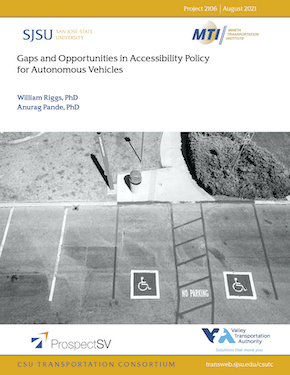- 408-924-7560
- mineta-institute@sjsu.edu
- Donate
Gaps and Opportunities in Accessibility Policy for Autonomous Vehicles
Nearly 1 in 5 people in the US have a disability (more than 57 million) (U.S. Census Bureau), and people with disabilities use the automobile as a travel mode at significantly lower rates than people without disabilities (Bureau of Transportation Statistics). For example, people aged 18 to 64 with disabilities make 28% fewer trips per day (2.6 v. 3.6 trips) on average than people without disabilities. The disparity is even more significant for non-workers. These statistics highlight the notable technological, design, and policy failings in today’s transportation system - that disabled individuals have considerable suppressed demand for travel that is currently not being met. Even among people who are able to take the trips, a significant proportion of people with disabilities rely on modes of transportation that were not specifically designed for their needs (Bureau of Transportation Statistics). Though the technology to substitute conventional cars with the much talked about autonomous vehicles (AVs) is not entirely ready, some existing technologies might be helpful for persons with disabilities. That said, several companies are creating prototypes of AVs specifically designed to cater to the travel needs of disabled individuals. Once autonomous vehicle technology is sufficiently mature, they have the potential to help disabled Americans achieve their desired level of mobility (Claypool et al.). While autonomous vehicles are being built with the purpose of curbing people’s need to operate the vehicles, lack of ability to drive is not the only barrier people with disabilities face while traveling. The simple acts of entering and getting out of the vehicle might pose difficulties for many disabled people, not just wheelchair users. This makes well-thought-out considerations for people with disabilities essential at the early stages of design and development.
WILLIAM RIGGS, PhD, AICP, LEED AP
William (Billy) Riggs is an Associate Professor at University of San Francisco. He is a global expert and thought leader in the areas of autonomy and smart transportation, housing, economics, and urban development.
ANURAG PANDE, PhD
Anurag Pande is a Professor of Civil Engineering at California Polytechnic State University, San Luis Obispo. His research interests include before-and-after evaluations, traffic operations, and safety of all road users.
-
Contact Us
San José State University One Washington Square, San Jose, CA 95192 Phone: 408-924-7560 Email: mineta-institute@sjsu.edu






